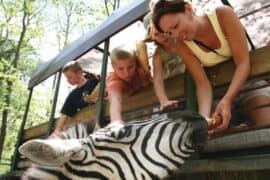Happy Trails and Safe Tales: Understanding Copperhead Snakes
Welcome, lovely parents! Are you ready to embark on a wildlife adventure with your kiddos? ?? Before you hit the great outdoors, let’s chat about a common neighbor you might encounter on your excursions – the copperhead snake. Gaining knowledge about these slithery beings ensures your family frolics safely in nature. So, grab a cup of your favorite beverage, and let’s dive into the fascinating world of copperheads!
Identifying a Copperhead Snake
First things first, being able to identify a copperhead is crucial for keeping your loved ones safe. Here are some features to look out for:
- Beautiful Yet Deceptive: Copperheads have gorgeous, distinctive patterns that can easily blend into the forest floor. Keep an eye out for their hourglass-shaped bands on a base of tan to pinkish-brown skin.
- Distinguishing Features: They sport triangular heads, with a copper-red coloration that gives them their name, and have vertical pupils similar to cats.
- Size Matters: Adult copperheads typically range from 2 to 3 feet in length, so if you’re seeing a snake that matches this description, it’s best to keep a respectful distance!
Where the Wild Ones Roam: Copperhead Habitats
Understanding where copperhead snakes like to hang out can greatly reduce an unwanted game of hide and seek. Copperheads are versatile in their housing choices:
- Forested Areas: These snakes adore wooded areas with plenty of leaf litter to camouflage themselves.
- Rocks and Hillsides: Rocks provide excellent sunbathing spots for these reptiles since they’re cold-blooded and need the sun’s warmth to regulate their body temperature.
- Near Water: While not necessarily aquatic, copperheads enjoy the vicinity of water sources like streams and ponds, as they attract their prey.
- Your Own Backyard: Yep, these creatures can sometimes be found in suburban areas, especially if their natural habitat overlaps with human living spaces.
Curious Kiddos and Copperheads: Minimizing Encounters
Now, how do we keep our adventurous little ones from stumbling upon these snakes? Here are some tips to minimize chances of any encounters:
- Education is Empowerment: Teach your children about copperheads – what they look like, where they may be found, and the importance of keeping distance.
- Pristine Play Areas: Keep your yard tidy, with the grass cut short, and remove any potential snake hideouts such as piles of leaves, rocks, and logs.
- Guided Adventures: Always accompany your kids on nature walks and stick to well-trodden paths.
- Dress for Success: When heading into possible snake territories, ensure everyone wears closed-toed shoes and long pants for extra protection.
Our guide is just getting started, dear parents! There’s a whole lot more to learn about these copper-hued neighbors. As you continue to explore the world with your little explorers, remember that knowledge and cautious respect for wildlife can turn every outdoor adventure into a happy, safe, and educational experience. Stay tuned for more insights into copperhead behavior, first-aid procedures for snake bites, and wilderness best practices!
Up next: We’ll talk about the behavior of copperhead snakes and how we can coexist peacefully with our serpentine friends. Plus, learn how to spot the signs of a snake’s presence and what steps to follow if you do encounter a copperhead on your family’s outdoor journey.

5 Things Parents Should Know in Preparing for Copperhead Snakes
1. Understanding Copperhead Behavior: Nature’s Quiet Residents
Copperhead snakes are generally not aggressive and will often freeze or slowly slither away if they sense humans nearby. They strike only when they feel threatened or provoked. Knowing this can help keep panic at bay if you do bump into one. During cooler months, they’re less active, so you’re less likely to encounter them on your wintery walks.
2. Seasonal Activity Patterns: When Are They Most Active?
These reptiles are most active from late spring to early fall. They tend to come out in the evenings or early mornings when it’s cooler. Planning your family outings during the day, particularly when the sun is out, can help reduce the chances of crossing paths with these critters.
3. Pre-Adventure Safety Chat: Talks to Have Before Heading Out
Have an engaging and age-appropriate conversation with your children about the importance of watching where they step and not picking up or touching wildlife. Instill in them a sense of respect for all creatures, emphasizing the “look but don’t touch” principle.
4. Know the Signs: Indications of a Nearby Copperhead
Awareness of signs can be your superpower! Copperheads leave distinctive trails and may shed skins in their habitat. They may also be accompanied by a unique odor, described by some as similar to cucumbers or watermelon, which can serve as a signal to stay vigilant.
5. Emergency Planning: Hope for the Best, Prepare for the Worst
No one wants to imagine a snake bite, but being prepared is better than being caught off guard. Ensure you have a basic first aid kit while hiking and know the nearest location for medical assistance. Importantly, educate yourself on first-aid procedures specifically for snake bites and have emergency contacts readily available.
Peaceful Coexistence: Respecting Nature’s Boundaries
Understanding the behavior of copperhead snakes can lead to a harmonious existence. These creatures play an important role in our ecosystem, controlling rodent and insect populations. By respecting their space and teaching our children to do the same, we can safely enjoy our shared environment.
Signs of a Snake’s Presence and Steps Following an Encounter
Sometimes, despite our best efforts, we may encounter a copperhead. Look for signs like fleeing wildlife, unusual silence, or a sudden rustling without a visible cause. If you see a snake:
- Stay Calm: Gently guide your kids to slowly back away from the snake and give it space to move on.
- Distract and Delight: Shift your children’s focus by turning the encounter into a learning moment or distract them with another activity at a safe distance.
- Report Sightings: If you’re in a park, let the rangers know about the snake for the safety of others.
By being alert, informed, and respectful, you can ensure that your family’s experiences outdoors are both delightful and secure. Copperhead snakes may be among the creatures you encounter, but with this knowledge, you can step confidently into nature’s embrace and create happy, lifelong memories with your little adventurers!
For more great fun click here. For more information see here
Disclaimer
The articles available via our website provide general information only and we strongly urge readers to exercise caution and conduct their own thorough research and fact-checking. The information presented should not be taken as absolute truth, and, to the maximum extent permitted by law, we will not be held liable for any inaccuracies or errors in the content. It is essential for individuals to independently verify and validate the information before making any decisions or taking any actions based on the articles.




